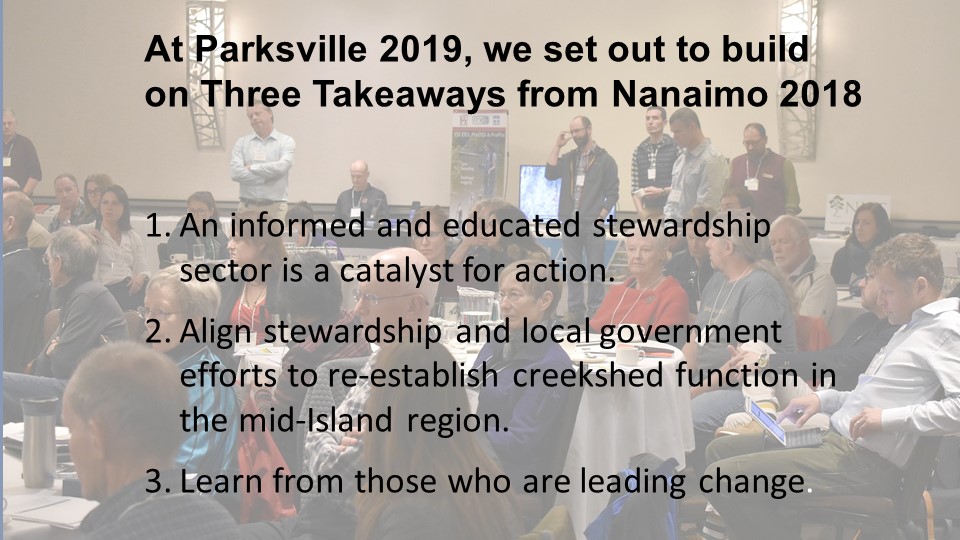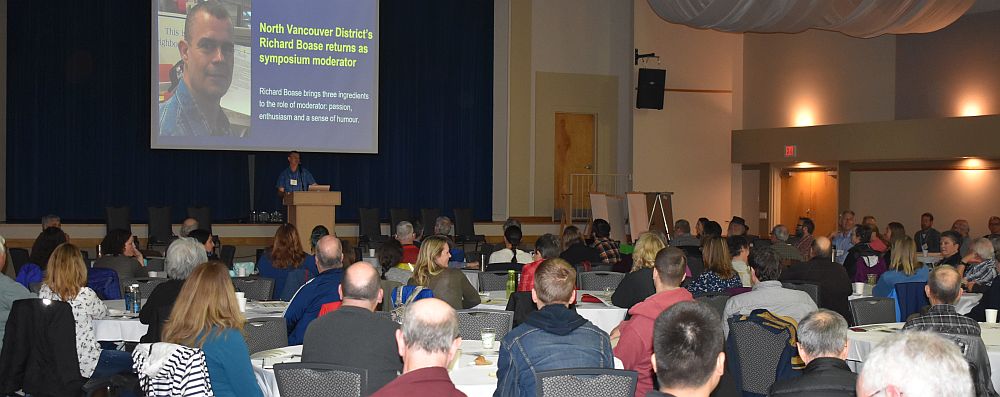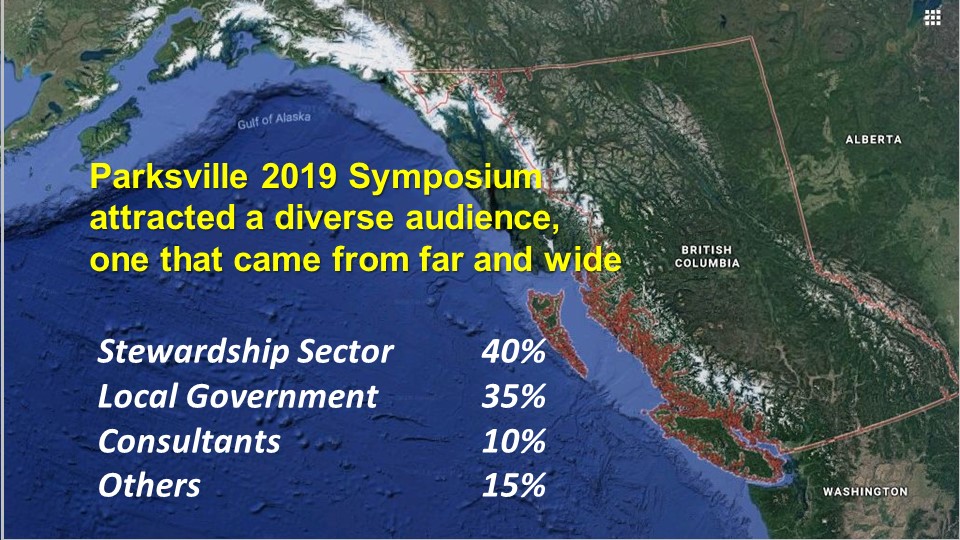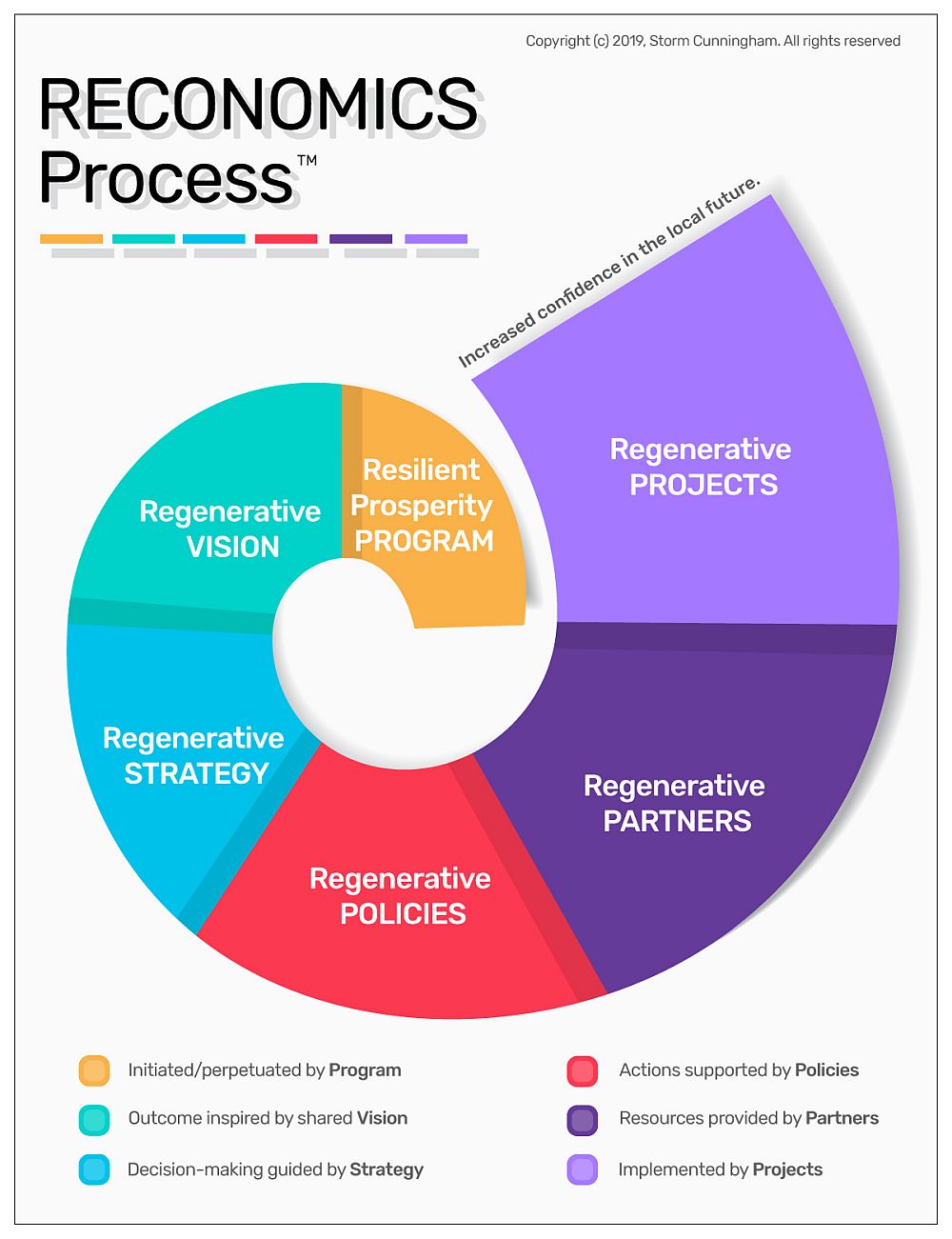PARKSVILLE 2019 SYMPOSIUM: “As the online survey showed, this ‘convening for action’ event met or exceeded expectations for 95% of delegates; furthermore, the event was successful because the right players were present, the urgency for meaningful collaboration was recognized, and ‘can do’ success stories were shared,” stated Kim Stephens
Note to Reader:
The article below is structured in four parts to provide an overview of what was accomplished at and by the Parksville 2019 Symposium.
The first part explains why the Nanaimo 2018 Symposium established a high bar for Parksville 2019, and introduces the challenges in daring to be bold in appealing to a diverse audience.
The second part then describes three objectives that guided the actions of the Parksville 2019 Organizing Committee, how those objectives provide a framework for assessing success, and summarizes what the online survey of delegates revealed about expectations being met and exceeded.
The third area of discussion identifies and comments on program elements that really stood out. It also includes reflections on what could be better.
In reflecting on the need to do business differently in order to “improve where we live through restorative development”, the fourth and final part elaborates on why it take a process to create an actionable vision, both for community revitalization and creekshed restoration. It concludes with this takeaway message: A vision with a task is the hope of the world.

Nanaimo 2018 Established a High Bar for Parksville 2019
 “Parksville 2019 was an ambitious undertaking for the Partnership for Water Sustainability and our NALT and MVIHES partners, and the collaborating agencies – Regional District of Nanaimo, Province of BC and DFO. It was the first time that we hosted a 3-day event, which is an exponential increase in workload compared to a single-day event,” stated Kim Stephens, Executive Director, Partnership for Water Sustainability.
“Parksville 2019 was an ambitious undertaking for the Partnership for Water Sustainability and our NALT and MVIHES partners, and the collaborating agencies – Regional District of Nanaimo, Province of BC and DFO. It was the first time that we hosted a 3-day event, which is an exponential increase in workload compared to a single-day event,” stated Kim Stephens, Executive Director, Partnership for Water Sustainability.
A Bold Leap of Faith by Organizing Committee
“A challenge that the organizing committee faced, and this was viewed by all as a positive challenge, was to both recapture and build on the energy that was released at the Nanaimo 2018 Symposium. The energy and enthusiasm in the room that day in April 2018 was simply amazing. It was palpable.
“In his closing remarks at Nanaimo 2018, our moderator Richard Boase boldly announced the committee’s spur of the moment decision to organize a follow-on symposium in 2019 – and with Storm Cunningham as the headliner. The audience erupted in a cheer! How often does that happen?
“Looking ahead a year, the bar had been raised indeed. Expectations were high. The Parksville 2019 Organizing Committee had our work cut out for us. Now we had to deliver.

An Over-Arching Message: Collaboration is Powerful
“In embarking on this year-long journey, our vision and mission was to demonstrate the power of collaboration between the stewardship sector and local governments, and give folks hope that good things would flow from such collaboration. Hence, our main focus was on showcasing success stories that would be inspirational. At the same time, we had to bring to life the phrase ‘improve where we live through restorative development’.
“This meant that we had to connect the dots between the two ideas in order to demonstrate that some communities are moving beyond rhetoric. Or, expressed another way, an over-arching message is that collaborative successes over a long period of time are the first steps in proceeding along a pathway that ultimately results in restorative development.
Compelling Program Resonates with a Diverse Audience
“It was a balancing act to weave together the elements that became the Parksville 2019 storyline. We had to keep in mind the breadth of our target audience, ranging from streamkeepers to elected representatives. We strived to ensure that the storyline would resonate with all. In other words, that there would be something compelling for everyone.
“Clearly we succeeded. Not only did close to 200 delegates come from far and wide, they represented a spectrum or continuum of backgrounds and interests. It was indeed a diverse audience. The feedback comments in the online survey indicate that delegates coalesced around the idea of an actionable vision for improving where we live,” concluded Kim Stephens, in distilling what the online survey revealed.

Program Objectives Provide a Framework
for Assessing Symposium Outcomes
“We succeeded in delivering on what we promised,” continued Kim Stephens. “The results of the online survey, both quantitative and qualitative, show that Parksville 2019 met or exceeded expectations for 95% of delegates.
“Did it have the same WOW factor as Nanaimo 2018? No, it did not. In retrospect, Nanaimo was unique in the way it brought together ‘the right people in the right place at the right moment in time’. The crowd that day was on fire. How often does that happen?
“Parksville 2019 had a different impact on the audience. It could be described as ‘more thoughtful’. The event was successful because the right players were present, the urgency for meaningful collaboration was recognized, and examples of ‘can do’ success stories were shared.
Program Objectives / Desired Outcomes
“Realistic self-assessment is essential when judging the extent to which an event met the stated objectives for characterizing success.
“In embarking on the program design for Parksville 2019, the organizing committee set out to achieve three objectives which in turn defined three desired outcomes: 1) attract an audience balanced across sectors; 2) demonstrate the power of collaboration between the stewardship sector and local governments; and 3) create an environment for sharing and cross-fertilizing experiences.
“Attracting a balanced audience depended on the effectiveness of the communication plan. It was the lynch-pin. Clearly, the plan worked. Over a period of 6 months leading up to Parksville 2019, we systematically published a series of e-newsletter articles that foreshadowed what would be addressed in storyline elements. This process both informed and established expectations.

Create Awareness and Establish Expectations:
“Attracting a balanced audience depended on the effectiveness of the communication plan. It was the lynch-pin. Clearly, the plan worked. Over a period of 6 months leading up to Parksville 2019, we systematically published a series of e-newsletter articles that foreshadowed what would be addressed in storyline elements. This process both informed and established expectations.
Program Design:
“Collaboration for the sake of collaboration is not enough. There must be a technical foundation that guides the collaboration. Thus, the daily themes for the symposium came into focus. To provide relevance for streamkeepers, the theme for Day One was Sustainable Stream Restoration. To capture the attention of those in local government, the theme for Day Two was Restorative Land Development.
- On Day One, we gave a crash course on ‘what you need to know’ to have a science-based understanding of causes-and-effects vis-à-vis stream health. The takeaway message was that one must understand what causes changes in hydrology before one can truly hope to restore ecology.
- On Day Two, our goal was to inspire delegates by showcasing ‘good news’ examples where there is a decade-long track record of success. It has so much more impact when one talks about what has been done versus what is still to come.
Group Dynamics:
“The intangible is what will happen when one brings together a diverse group. There is no way to predict the group dynamics. The objective is to create a safe environment so that individuals will feel comfortable sharing their views, and others will be respectful in listening and reflecting.
“One strives to find the right mix of ‘presenting at’ and ‘interacting with’. At the end of the day, what happens boils down to who is in the room.

Module Structure for Engaging an Audience
“We organized each day as four modules in order to proceed at a relaxed pace by allowing ample time for each module. Each had an educational objective. Because memories are short, each morning and afternoon session kicked off with a 15-minute context presentation. These set the scene for what was to come, while at the same reminding delegates of the big picture.
“The minimum time for each topic was one hour – that is far longer than the norm for conferences and workshops. The intention was to prime delegates for a discussion. We wanted them to absorb and reflect on what was most important.
“Yet, even with all the time set aside for audience interaction, folks said they wanted more. At times, it was hard to prevent a module from going overtime. And some folks let us know about that afterwards! They also wanted more networking time. This is great because it shows the audience was engaged.
Online Survey Yields Invaluable Data
“Did Parksville 2019 achieve the stated educational objectives of the committee? Yes, it did, and in spades. The online survey provides conclusive evidence. It is a treasure trove of information. The number of responses exceeded expectations, by far. And delegates spent on average of almost 14 minutes describing what they learned, etc. Wow!
“The remarkable size of the sample (40%) gives the organizing committee absolute confidence that the findings are definitive and truly representative of delegates as a whole. A selection of ‘stand-out’ quotes that capture the moment are listed as follows:
- “The Vancouver Island symposium on water stewardship was so inspiring and informative. It was a wonderful experience. I left Parksville feeling hopeful.”
- “It was an exciting few days, and I left feeling inspired and even somewhat empowered about finding ways to protect water. The importance of ecological services really hit home for me.”
- “Everything learned was valuable and complementary, from Dave Derrick to Storm Cunningham and all the presenters in between, there wasn’t one presentation I did not learn something from.”
- “I am a new streamkeeper and attending the Symposium for the second year really helps to inform me about how to move forward with restoration and remediation and to not lose hope for positive changes from municipal, regional, provincial and federal jurisdictions.”
- “The symposium reloaded/refreshed my tool belt with science, connections, examples of how tools are used, and how to build or re-purpose tools.”
- “Again, from learning to look at a waterway differently from Dave Derrick; to learning more about strategy and processes from Storm Cunningham; every presentation and conversation taught or expanded my knowledge in some way.”
- “The practical techniques that I learned at this conference can be applied to projects in my neighbourhood. I will look at streams differently now that I have a better understanding of how they function and move over time.”
- “The connections I made/strengthened and the knowledge gained at this symposium will be a great asset in allowing me to move forward with sustainability actions. I have a relatively clear picture of what actions I can take and which organizations I can partner with
- “It always comes down to communication and collaboration. Local Governments are rarely in complete control of the land or have all of the resources to make change. Partnerships are crucial. Also, watershed restoration is a long game that can take place incrementally over a very long period of time. Each increment should be measured as success, not just the final outcome.”
- “I learned important information regarding what others are doing about issues that we are having in our own local watersheds and how to present information regarding our water quality. It was especially exciting to have the very people who can help us right there at the symposium and how willing they were to follow up with us.”
- “The Bowker Creek presentation was inspiring. I liked that they developed a broad vision and a plan, which became the go-to for any other planning and development events or opportunities that arose.”
- “Please keep up the good work of providing such a good place for scientists, stewards and others to learn about our rivers, streams. It’s important to see the connection to everything that lives in this environment and especially us and how we can learn to be much less destructive,” is a quote that sums up the big picture and captures the essence of why folks attended.
“The foregoing quotable quotes are gratifying. They provide the organizing committee with a strong measure of reassurance on the nature of how expectations were met. We appreciate that delegates took time to provide thoughtful and inspiring reflections.
What Next: Vision for Reconnecting Hydrology and Ecology
“There was an abundance of written suggestions from delegates as to WHAT NEXT for the Vancouver Island Symposium Series on Water Stewardship in a Changing Climate. One that stood out was the ambitious idea for watershed meetings :
“I would suggest you develop a template for a facilitated meeting, maybe an afternoon once a year per watershed, between stewardship groups and the local government of that watershed. This would include staff and elected officials with stewardship groups, to discuss successes, what could be improved, goals and future plans. I would like to up the level of importance of communication between local governments and stewardship groups.”
“In essence, the writer describes what is ultimately necessary to create the energy and momentum to achieve this desired outcome: implement an actionable vision that would reconnect hydrology and ecology. Realization of this outcome would fundamentally improve where everyone lives,” stated Kim Stephens, in providing a summary assessment.

A Perspective on How / Why Program Elements Stood Out
“Parksville 2019 started strong and finished strong,” emphasized Kim Stephens. The field day was a big hit, in large part due to the charismatic personality of stream restoration innovator Dave Derrick in conducting both the classroom and outdoor lectures. The public lecture and finale presentation by Storm Cunningham on restorative development struck a responsive chord with the audience. This prompted Storm to write a reflective article about his observations.
Restorative Land Development
“The 3rd day of Parksville 2019 was especially strong for two reasons. First, the involvement of twenty Master’s students from Vancouver Island University as facilitators in an engagement session (for the RDN’s Drinking Water & Watershed Protection program) had a noticeable impact on delegates, especially when the students entered the room en masse.
“Involvement of the students extended the collaboration across the generations, providing an opportunity for future leaders and planners to be involved in the discussions.
“Secondly, the inspirational nature of the module titled Beacons of Hope exceeded expectations. This was due, in large part, to the outstanding presentations that brought to life the Bowker Creek and Brooklyn Creek partnership success stories (in the Capital Region and Comox Valley, respectively).

Consensus of those in the Room
“The online survey also showed that one can never satisfy everyone. There will always be outliers. Therefore, what is paramount is the consensus of the room. And the consensus was that Parksville 2019 was inspirational. Judging by the overwhelming number of positive comments, there seems little doubt about that. The many high moments predominated over the few soft moments.
 “John Finnie, Chair of the Parksville 2019 Symposium Organizing Committee, put everything into perspective with this quotable quote:
“John Finnie, Chair of the Parksville 2019 Symposium Organizing Committee, put everything into perspective with this quotable quote:
“Parksville 2019 demonstrated that a group of 200 biologists, planners, engineers, streamkeepers, politicians, administrators, students and others, all with different backgrounds and responsibilities, can share a common learning experience and agree on strategies for water and land stewardship, and stream restoration. Truly a magical experience. The stage has been set for more and better things to come. Stay tuned.”
“We set out to bring together a diverse and balanced audience. And we succeeded. We informed. We educated. We inspired. The bar is now raised even higher for Comox Valley 2020, the next in the series.”
What Could Have Been Better?
“We strive to view all aspects of the 3-day program objectively. So, with the advantage of hindsight, what could the organizing committee have done better? Viewed through the committee’s own self-assessment lens, it is clear to the members that the Panel & Town-Hall sessions is one area where we should intensify our efforts in future – especially if we wish to replicate past successes in energizing an audience through town-hall interaction, such as at Nanaimo 2018.
“As is invariably the case, judging expected versus actual outcomes depends in large part on who was in the room and what were their expectations in attending. Another key consideration is facilitation effectiveness in drawing out those who are reluctant to put up their hands and ask questions or simply share their experiences. Expectations were high coming into Parksville 2019. Expectations were met. Delegates certainly left with copious amounts of food-for-thought. Yet we can always do better. That is our mantra. Do, learn, adapt and do better.” stated Kim Stephens in providing a summary assessment.

It takes a process to create an actionable vision for community revitalization + creekshed restoration, says Storm Cunningham
“It was the result of serendipity that Storm Cunningham was part of the program,” stated Kim Stephens. “Just weeks before Nanaimo 2018, he had reached out to me when he chanced to learn about the symposium and our interest in restorative development. His reaching out made the subject real to us, and opened the door to building him into the Parksville 2019 program.
“Storm Cunningham delivered two public lectures while in British Columbia. First, at the Parksville 2019 Symposium his theme was Nature is Regenerative: We Should Be Too. Then, as part of the Place-Making Vancouver Island Speakers Series, he spoke about Revitalizing Communities by Restoring the Environment.
“Afterwards, Storm Cunningham reflected on whether these two audiences fully grasped why they should care about how communities revitalize. This reflective process prompted Storm to write an article that would close the loop. The article provides a lens through which to understand why “Deconomics” describes the old way of doing business and “Reconomics” captures the new way.
“Storm’s reflections serve as a good takeaway for Parksville 2019. They describe a road map for action,” emphasized Kim Stephens.

Create An Actionable Vision to Build Momentum
“The first step is to create an ongoing revitalization (or resilience) program, which constantly initiates, perpetuates, evaluates and adjusts local renewal efforts,” wrote Storm Cunningham. “Without an ongoing program, you have little chance of building momentum, which is essential to increasing confidence in the future of the place, which—in turn—attracts more residents, employers and funding.
“The first job of that program (which is usually housed by a foundation or non-profit organization) is to facilitate a shared vision for the future. The second step is to create a strategy to implement that vision. Next, it’s best to do some policy work, adding policies to support that strategy, and removing policies that undermine it.”
Implement Projects Through Partnerships:
“Once all of that is done, it’s time to move into action. Recruiting public and private partners into your program is the next step. This provides the human, financial and physical (such as properties) resources needed to do actual projects, which are the ‘final’ step of the process. I put ‘final’ in quotes because regeneration is a never-ending activity, so the process is circular, not linear. A place that is no longer revitalizing is devitalizing. Stasis leads to decline.”
Role of the Stewardship Sector in the Process:
“Armed with a deep understanding of the above, Streamkeepers and other watershed heroes are no longer operating in a silo, dependent on others to champion and support their work. They are far more capable of being their own champions when face-to-face with funders, politicians and stakeholders.
“And, they will be better able to identify where in the revitalization/resilience process they or their organization should be engaged, in order to be most effective: the program, the visioning, the strategizing, the policymaking, the partnering or the projects,” concluded Storm Cunningham.

The components are familiar, so all places have some. But none have all. A process with missing components is not a process. You can add to it, but do not subtract.
A Vision with a Task is the Hope of the World
“Storm’s article prompted Eric Bonham to add his thoughts to provide an over-arching perspective on what Parksville 2019 represents in the Partnership’s journey for the past two decades. A former Director in two provincial ministries, Environment and Municipal Affairs, Eric Bonham is also a founding member of the Partnership for Water Sustainability.
A Step-by-Step Venture:
“The article that Storm wrote is a powerful package,” wrote Eric Bonham. “Storm succinctly captures the process which I believe the Partnership for Water Sustainability has doggedly tried to identify over time, not always knowing the next step.
“In essence, it is a step-by-step venture that has evolved over time through partnerships on a range of initiatives, some more successful than others, with local government, stewardship community, academy, First Nations and the business sector (Vancouver Island Economic Alliance).
“The Ecological Accounting Process (EAP) identifies the practicality, stewardship sector the passion, business sector the economy, and local government the policy. The call for integration is now timely and long overdue. The top-down bottom-up commitment still holds.
“Applying Storm’s process brings a holistic dimension to development with Vision and Task being at its centre and inextricably linked,” concluded Eric Bonham.


